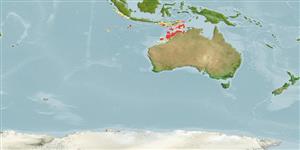Classification / Names
आम नाम | उपशब्द | Catalog of Fishes(वर्ग, प्रजाति) | ITIS | CoL | WoRMS | Cloffa
>
Ophidiiformes (Cusk eels) >
Dinematichthyidae (Viviparous brotula)
Etymology: Dinematichthys: Greek, di = two + Greek, nema = filament + Greek, ichthys = fish (Ref. 45335); trilobatus: Named for its inner pseudoclasper with 3 lobes (Latin trilobatus for three-lobed); an adjective..
More on authors: Møller & Schwarzhans.
Environment: milieu / climate zone / depth range / distribution range
पारिस्थितिकी
समुद्री प्रवाल-भित्ति संयुक्त; गहराई सीमा 0 - 50 m (Ref. 90102). Tropical
Endemic to the Christmas and Cocos Keeling Is.
आकार / वज़न / Age
Maturity: Lm ? range ? - ? cm
Max length : 4.6 cm SL पुल्लिंग / अलिंग; (Ref. 81230); 5.8 cm SL (female)
Short description
पहचान कुंजी | आकृति विज्ञान | मौरफोमैटरिक्स
पृष्ठीय सौफट रेज़ (सम्पूर्ण) : 80 - 87; ऐनल सौफट रेज़: 60 - 67; जानवरों की रीड़ का जोड़: 42 - 43.
Solitary inhabitant of rock and coral crevices in 0-50 m, cryptic (Ref 90102).
Life cycle and mating behavior
Maturities | पुनरुत्पत्ति | Spawnings | Egg(s) | Fecundities | लार्वा
Møller, P.R. and W. Schwarzhans, 2008. Review of the Dinematichthyini (Teleostei, Bythitidae) of the Indo-west Pacific, Part IV. Dinematichthys and two new genera with descriptions of nine new species. The Beagle 24:87-146. (Ref. 81230)
IUCN Red List Status (Ref. 130435)
Threat to humans
Harmless
Human uses
मात्स्यिकी: कोई रुचि बग़ैर
साधन
Special reports
Download XML
इंटरनेट स्रोत
Estimates based on models
Preferred temperature (Ref.
123201): 27 - 28.6, mean 27.9 °C (based on 22 cells).
Phylogenetic diversity index (Ref.
82804): PD
50 = 0.7500 [Uniqueness, from 0.5 = low to 2.0 = high].
Bayesian length-weight: a=0.00389 (0.00180 - 0.00842), b=3.12 (2.94 - 3.30), in cm total length, based on all LWR estimates for this body shape (Ref.
93245).
Trophic level (Ref.
69278): 3.3 ±0.5 se; based on size and trophs of closest relatives
Fishing Vulnerability (Ref.
59153): Low vulnerability (10 of 100).
